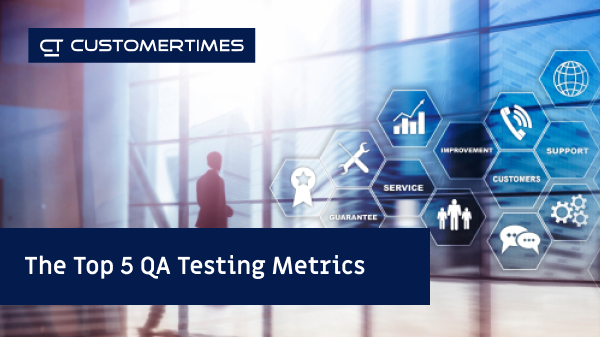The Top 5 QA Testing Metrics
By Ksenia Arkhipova - February 3, 2022
Customertimes has a well-established QA testing practice, with QA engineers around the world that handle product testing and help our clients reach their project goals and keep projects on track.
We work with various testing tools and testing types to improve the quality process and mitigate project risks, including code/no code automation approaches and API testing.
We’ve identified key metrics for each stage of the software testing process, and we’re breaking them down here by QA stage and offering a look at why each one is so important. After all, every line of code is a potential point of failure.
Test Design
Key Metrics:
- Test design coverage
- Test design productivity
Why it matters:
Test design coverage measures the percentage of test cases covered against the number of requirements and test design productivity quantifies the number of test cases created per day.
This is where product functionality is analyzed to uncover any issues on the end user side. Are there gaps in functionality? Are there roadblocks that might keep users from downloading the app?
This is where those potential problems are identified, and the QA team ensures that everything needed will be covered by test cases.
Test Execution and Bug Fixing
Key Metrics:
- Test completion status
- Test execution completion status
- Test case execution productivity
- Defect density
- Defect priority/defect severity
- Defect acceptance/defect rejection
Why it matters:
At this stage, it’s helpful to show the percentage of executed and completed tasks against the total amount of cases. Defect-related metrics allow the whole team to understand which bugs in which modules could critically affect the product and should be fixed first.
User Acceptance Testing
Key Metrics:
- Defect leakage
Why it matters:
This metric helps identify gaps in the testing strategy, including issues that may have been missed during initial business and/or functional requirements gathering.
Product Exploitation and Support
Key Metrics:
- Defect removal efficiency
Why it matters:
This metric quantifies testing effectiveness and shows how many defects were not found and fixed before production deployment. It helps identify necessary product strategy improvements to increase testing effectiveness for future releases.
Overall Metrics
Key Metrics:
- Effort variance/schedule variance
- Rework effort ratio
- Requirements creep
Why it matters:
These metrics measure the productivity of your testing plan. By calculating these, you can track the effectiveness of your test planning process and identify necessary enhancements.
Measuring Product Success
Establishing and tracking quality metrics is the most effective way to measure product success. An accurate validation process can quickly identify weak/potential problem areas that could negatively impact customer satisfaction.
But if you’re tracking the right metrics at each stage of the QA process, you have a much better chance of keeping your project on track and delivering an improved customer experience.
If you’d like to learn more about Customertimes’ QA testing strategies, we’d love to talk further. We take a very customer-centric approach to QA, leveraging a variety of cloud services, multi-browser testing, and best-in-class reporting to create a testing framework that gets outstanding results.
Reach out to us today, or read more about our DevOps and QA practices right here.

Need expert help?
The QA engineers at Customertimes can handle any DevOps project. Reach out, and let's keep your project on track.
Find a QA expert-fm-converted.jpg)
Ksenia Arkhipova
Ksenia is the QA Department Head at Customertimes.
-fm-converted.png)
The Importance of Agile in the CPG and Beverage Industries
-fm-converted.png)
Why You Need to Break Away From Those Legacy Systems
-fm-converted.png)
AI in Action: Real-World Examples and Success Stories
-fm-converted.png)
Achieving a 360 View with API-Led Connectivity in Your Integration
-fm-converted.png)
Artificial Intelligence in Healthcare: Transformative Potential
-fm-converted.png)
Eight Proven Growth Strategies from Healthcare & Life Sciences Leaders
-fm-converted.png)
Overcoming Apprehension around Emerging Technologies
-fm-converted.png)
How to navigate the challenges of implementing innovative tech in healthcare
-fm-converted.png)
How AI is Improving the Work of Pharma Sales Reps
-fm-converted.png)


